Ag News
Tropical Storm Debby deluges Georgia farms, wipes out roads.
Posted on Aug 16, 2024 at 9:40 AM
By Jennifer Whittaker
More than a week after Tropical Storm (TS) Debby crawled across Southeast Georgia Aug. 5-6, farmers and rural residents in her path are still evaluating crop damage and dealing with washed out roads the storm left in her wake.
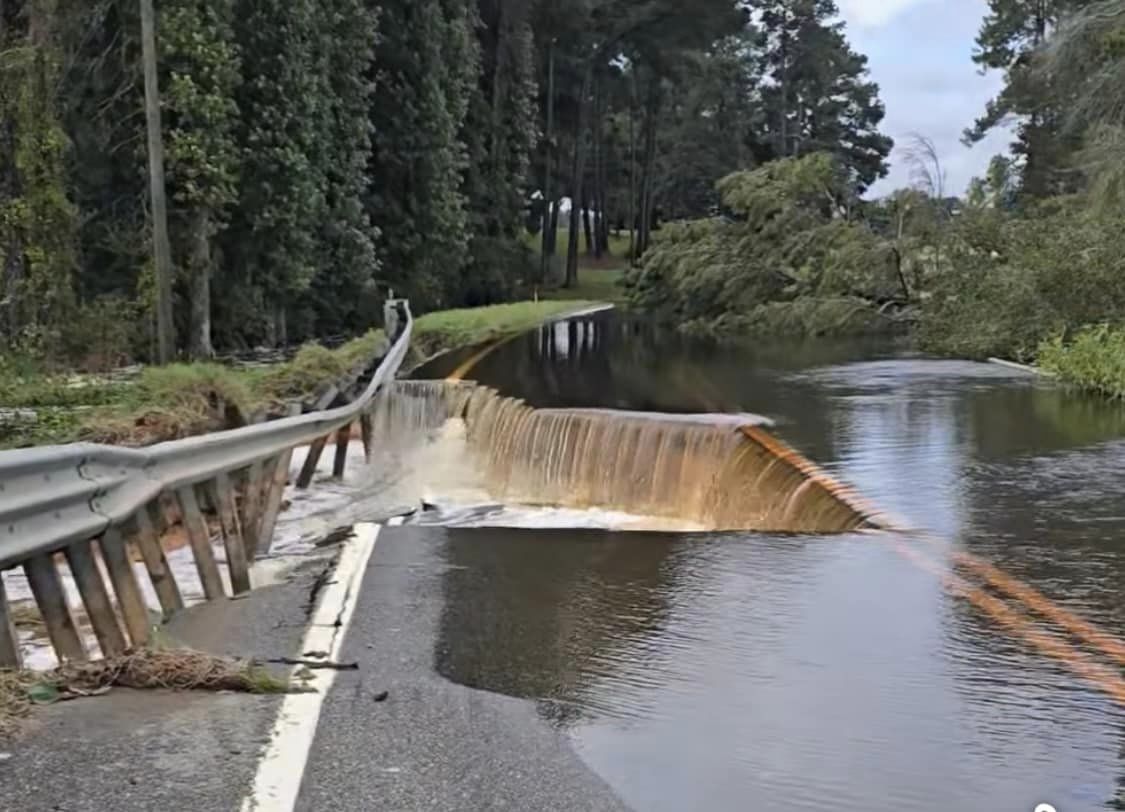
Highway 169 in Tattnall County's Mendes Community was washed away after historic flooding caused by Tropical Storm Debby. / Photo by Debra Dasher
TS Debby traveled a route very similar to the one Hurricane Idalia took last year crossing the Florida line near Valdosta and moving north through counties including, but not limited to: Thomas, Brooks, Lowndes, Echols, Lanier, Clinch, Berrien, Irwin, Ware, Bacon, Pierce, Appling, Toombs, Evans, Tattnall, Bulloch, Effingham and Screven counties to the South Carolina line and across to the Georgia coast.
Rainfall between 5-10 inches fell from Valdosta to Vidalia to Statesboro and points to the east, Georgia Emergency Management Agency Meteorologist Will Lanxton reported Aug. 6. By the morning of Aug. 7, Lanxton reported that 8 to 12 inches of rainfall had accumulated across South-Central, Southeast, and East-Central Georgia. Parts of Effingham, Screven and Bulloch counties received over a foot of rain from Debby. These rainfall totals align with a 100-year flood recurrence interval, Lanxton reported.
“This week has been tough. Tropical Storm Debby has been a significant issue for Southeast Georgia. Keep our farm families in your prayers,” Georgia Commissioner of Agriculture Tyler Harper said Aug. 8 while speaking at the Georgia Farm Bureau Commodity Conference in Tifton. “If you’re in the impacted zone, the most important thing is to document, document, document any damage your crops or farm suffered. We’re hearing reports that Georgia’s tobacco crop has been destroyed for all practical purposes. We’ve heard reports of some peanut and cotton fields having been flooded, which could lead to disease pressure that affect yields on down the line. We had some poultry houses that were flooded, and chickens were lost. We’re working to assess damage and collect data to see where we’re at to work on getting disaster assistance.”
Debby was more of a rain event than a wind event, UGA Weather Network Director & Agricultural Climatologist Pam Knox said.
“The highest gusts in Georgia were in the range of 55-60 mph, mostly in Southeastern Georgia or near the coast,” Knox said. “This means it was not as strong a wind event as Hurricane Michael in 2018, the peak gust in Georgia from that storm was 115 mph. TS Alberto in 1994 had a maximum rain amount of over 27 inches, so we were not very close to that either.”
Report damage to your USDA Service Center
Farmers who suffered losses from Tropical Storm Debby and whose crops are covered for the crop year by the Federal Crop Insurance Program or the Noninsured Crop Disaster Assistance Program (NAP) are reminded to report crop damage to their crop insurance agent or local FSA office. Producers are encouraged to report damage within 72 hours of discovering the damage and follow up in writing within 15 days.
Producers must keep accurate records to document damage or loss and to report losses to their local USDA Service Center as soon as possible. After a storm, always take photos of your damage and crop loss to turn into USDA.
Due to federal law, producers should not perform any cleanup efforts until your local FSA/USDA service center has completed an evaluation UNLESS there is an immediate threat to human life. Failure to comply could jeopardize a producer's payment eligibility.
“Once you are able to evaluate the impact on your operation, be sure to contact your local FSA county office to timely report all crop, livestock and farm infrastructure damages and losses,” said Nikki Thomas, acting executive Director for FSA in Georgia. “To expedite FSA disaster assistance, you will likely need to provide documents, such as farm records, herd inventory, receipts and pictures of damages or losses.”
Disaster programs for producers offered by USDA’s Farm Service Agency (FSA) include:
• The Tree Assistance Program provides cost-share assistance to rehabilitate or replant orchards and vineyards when storms kill or damage trees, vines, or bushes. NAP or Federal Crop Insurance often only covers the crop, not the plant.
• The Emergency Conservation Program and Emergency Forest Restoration Program can assist landowners and forest stewards with financial and technical assistance to restore damaged farmland or forests.
• Livestock Indemnity Program (LIP) is for producers who experience livestock deaths in excess of normal mortality or have to sell injured livestock at a reduced price. To participate in LIP, producers will have to provide acceptable documentation of death losses or evidence of reduced sales resulting from an eligible adverse weather event and must submit a notice of loss to the USDA Farm Service Agency (FSA) no later than the annual program payment application date, which is 60 calendar days following the calendar year in which the loss occurred. The LIP payment application and notice of loss deadline is March 3, 2025, for 2024 calendar year losses. Livestock producers who experience losses related to hurricanes should check with their local FSA office for LIP eligibility criteria.
• Emergency Assistance for Livestock, Honeybees & Farm-Raised Fish Program (ELAP) provides eligible producers with compensation for feed and grazing losses. For ELAP, producers are required to complete a notice of loss and a payment application to their local FSA office no later than the annual program application deadline, Jan. 30, 2025, for 2024 calendar year losses.
Visit https://gfb.ag/usdadisasterprogramsinfo for more info on USDA disaster programs.
Tobacco crop shows immediate damage
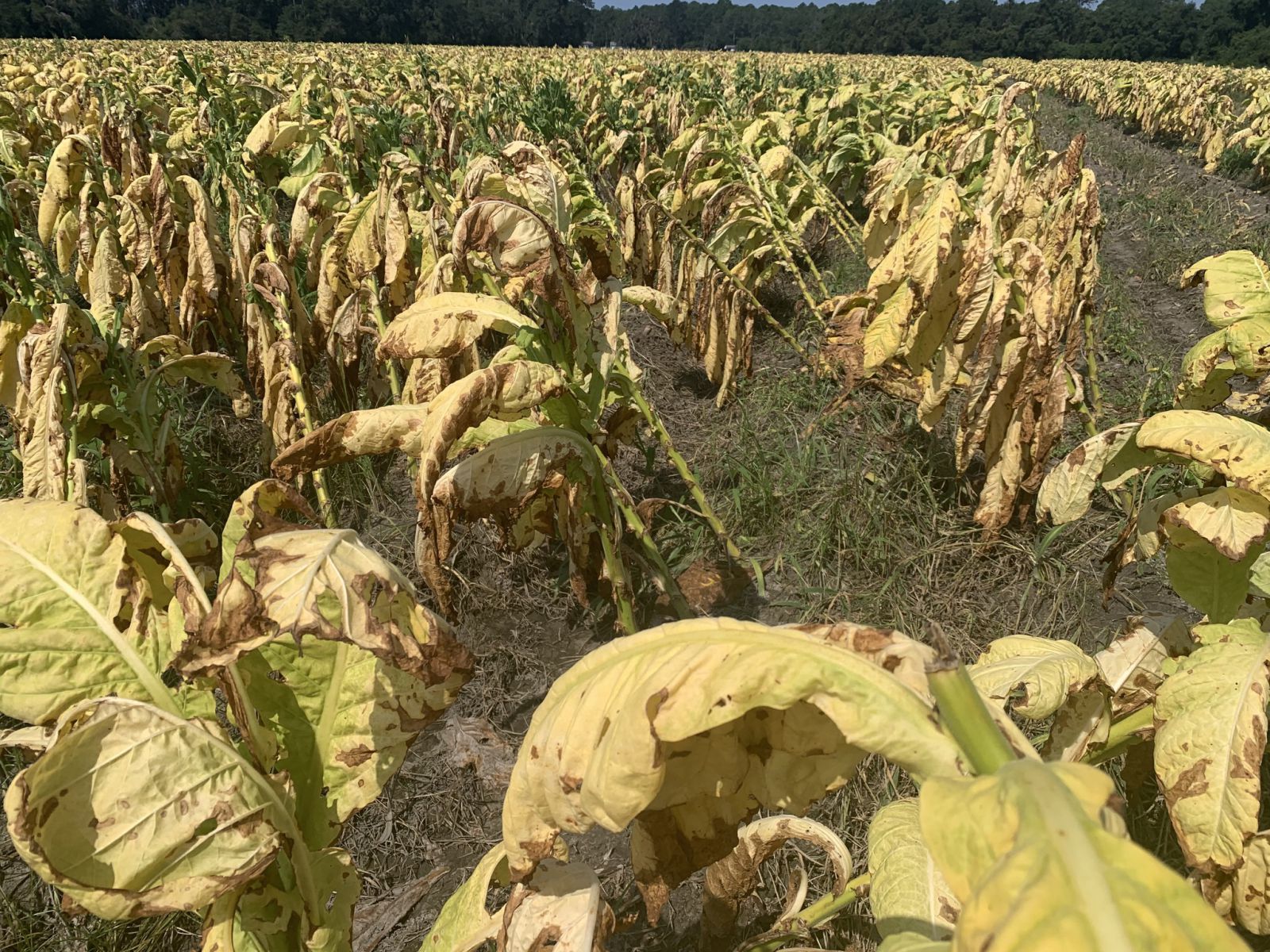
Photo courtesy of UGA Extension Tobacco Agronomist J. Michael Moore
TS Debby couldn’t have come at a worse time for Georgia tobacco producers as they had finished growing their crop and were only starting to harvest it. UGA Extension Tobacco Agronomist J. Michael Moore estimates only 15% of Georgia’s crop had been harvested Aug. 5, when the storm arrived in Georgia.
Tobacco growers harvest their crop in phases starting at the bottom of the stalk near the ground.
“This is the lowest quality [of the crop] and brings the lowest price,” Moore said. “However, this may be some of the best [tobacco] that some growers have to sell from their crop this year.”
Pierce County tobacco grower Daniel Johnson estimates he had harvested about 15% of his 540-acre tobacco crop when Debby blew in Aug. 5, bringing 8.5 inches of rain to his farm. As of Aug. 13, Johnson estimates Debby cost him 290 acres of his total crop or about 54%.
“I’ve had losses before but not to this extent. “It’s bad. We’re expecting catastrophic loss,” Johnson said. “We had 73 barns picked but still had about 300 barns worth of tobacco in the field.”
If there are any good spots of tobacco left in the fields, Johnson said he’ll pick those and harrow under what goes bad.
Moore says tobacco damage was sustained from the excess rain and wind damage.
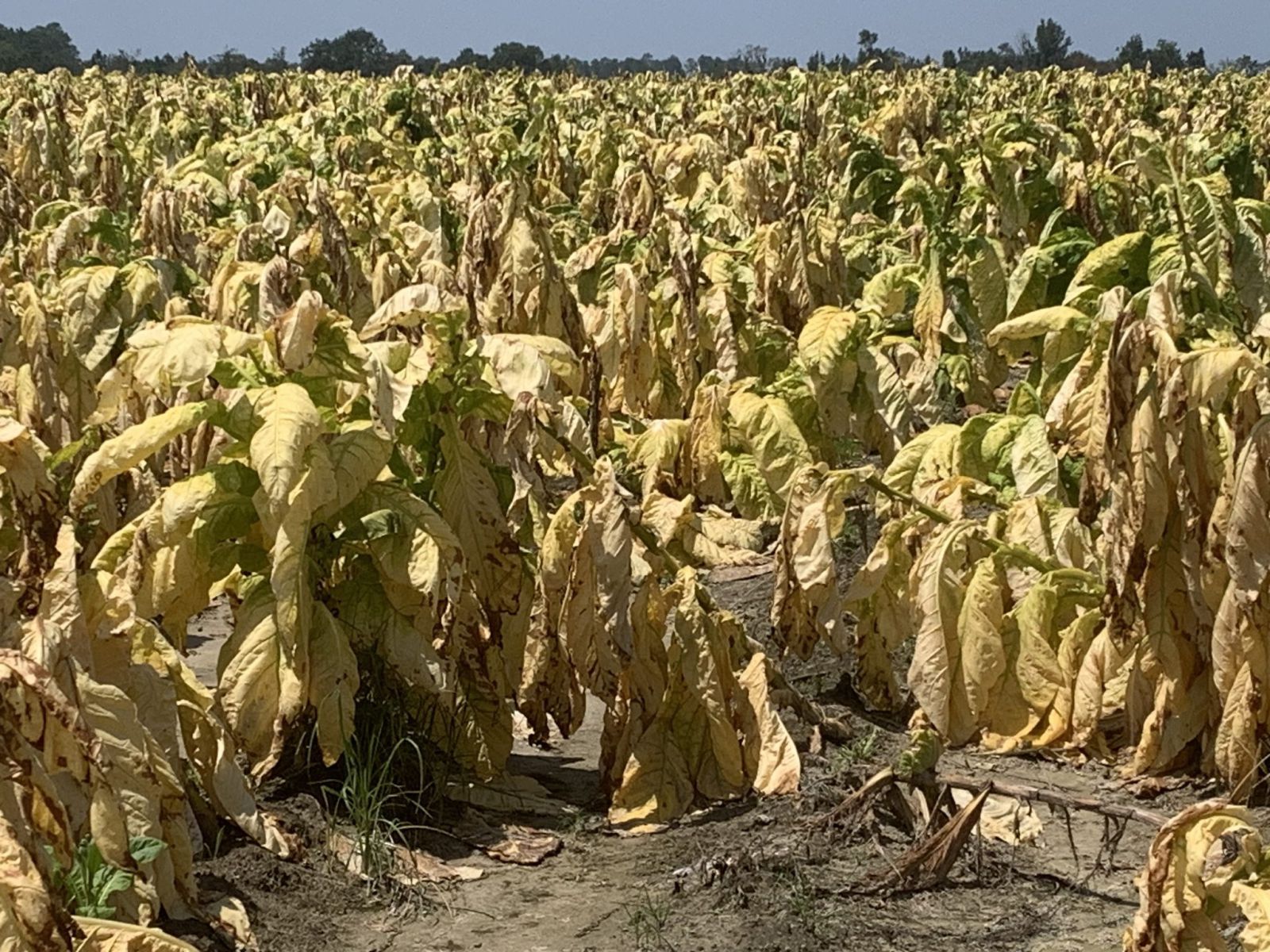
Photo courtesy of UGA Extension Tobacco Agronomist J. Michael Moore
“Leaves that are whipped by the wind for long periods of time are bruised and release natural ethylene which accelerates the yellowing process,” Moore explained. “This is faster in plants that are nearing maturity and whose root system is killed by oxygen deficiency from drowning.”
Moore said previous thunderstorms the weekend before Debby in parts of Georgia’s tobacco belt caused saturated soils. Debby’s winds blew over some tobacco stalks, breaking roots that support the leaves on the upper parts of the plants.
The amount of rain Georgia tobacco growers got from Debby ranged from 2 inches in the Thomas/Brooks County area, to six to 12 inches with lower amounts as the storm moved east of Echols to Appling and Wayne County, Moore said. Rainfall seemed to be the heaviest as Debby moved north towards Evans, Bulloch and Screven counties.
Screven County grower Brant Clifton received 12 inches from Aug. 5 through the night of Aug. 6 after having received two inches Aug. 3.
“I had an excellent crop before the storm came through, probably as good a crop as I’ve ever had,” Clifton said. “At this point we’ve done everything you’re supposed to do to grow a good crop. The only thing left to do was to harvest it. There’s nothing we can do now to make this better. If this had happened around Memorial Day, there may have been some things we could have done to salvage the crop.”
Clifton couldn’t get back in his fields to start harvesting his crop until Aug. 13 because the dirt road his farm is on had several deep washouts.
“I was waiting to get dirt to rebuild the road so we could get our equipment into the fields,” Clifton said.
Clifton estimates he’s lost 40 to 50% of his crop – “That’s what Debby drowned,” he said. “The other 60% that didn’t drown, I don’t know how good the quality will be when or if we can harvest it.”
Clifton grew up on a tobacco farm and took over the family operation from his dad in 1999. He says this is the worst storm he remembers, since he’s been farming on his own.
“We grow our tobacco on high land. We try to plant it on land where water won’t stand, but I never dreamed we’d get 14 inches of rain at one time,” Clifton said.
The only storm that comes close for him, Clifton said, was Tropical Storm Bonnie that hit his farm Memorial Day 2016 leaving behind 7 inches of rain.
“I have never seen as much damage to the flue cured tobacco crop as a whole as this hurricane has caused,” Moore said.
For tobacco companies, the bad news is Debby hit growers from Newberry, Fla., through the Carolinas to Danville, Va.
“The crazy thing is, believe it or not, there’s a shortage of tobacco worldwide because Brazil and Zimbabwe had bad crop years,” Johnson said.
Cotton & Peanut damage still being evaluated
Jay Stone contributed content to this section.
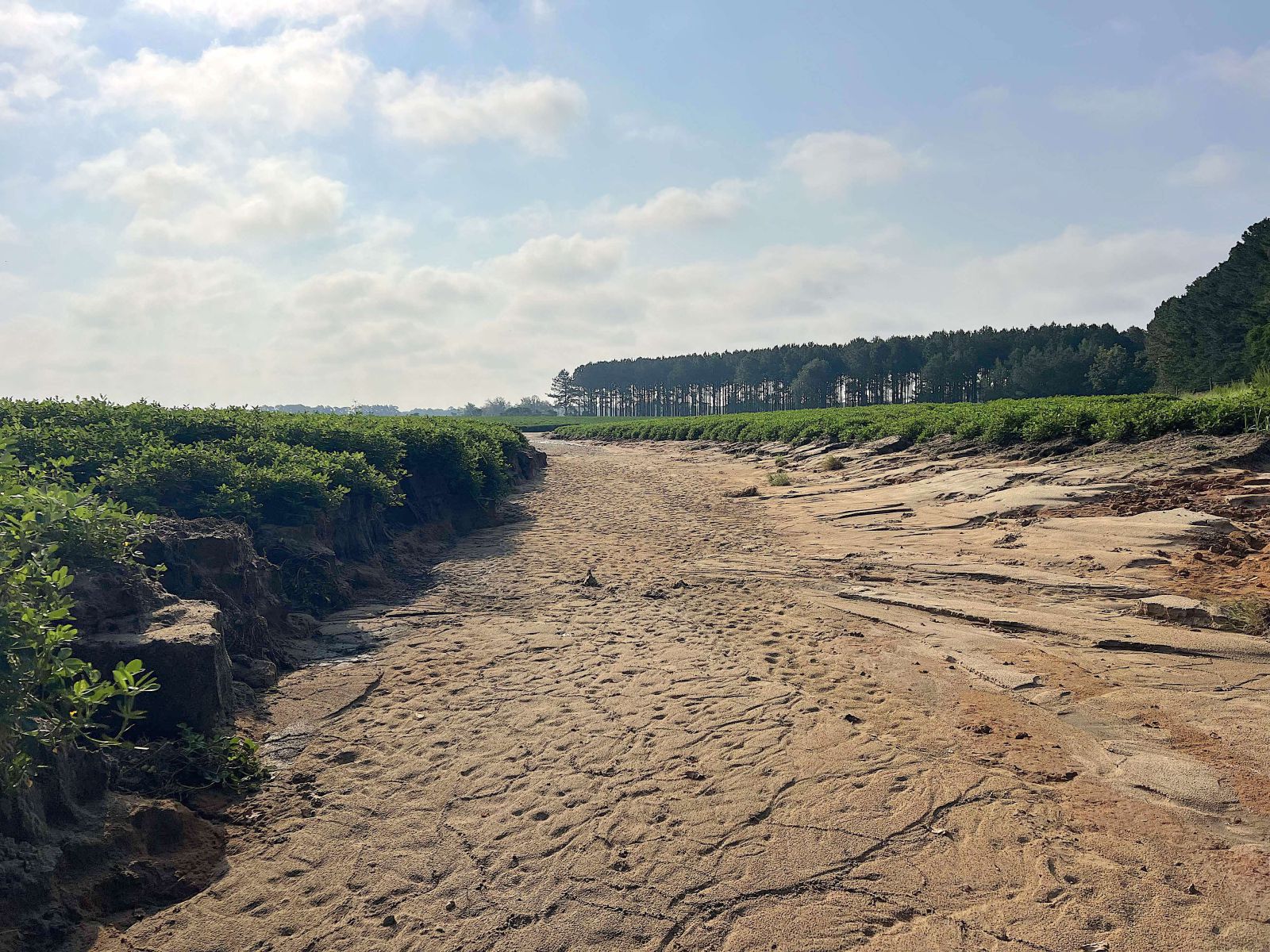
Tropical Storm Debby washed away this section of Lindy Sheppard's peanut field in Screven County. Prior to the storm, peanuts covered all of the dirt in the middle of the photo that now looks like a road. / Photo by Whitney Sheppard.
UGA Extension Cotton Agronomist Camp Hand said much of the damage to the state’s cotton crop may not be realized for some time, in part because field access is limited due to flooding and excess soil moisture.
“There were certainly direct impacts with lots of rain, some wind, and overcast conditions but my major concern are the more indirect losses that we’ll see from road access being limited following the storm,” Hand said. “This will hinder timely crop protectant applications, and depending on how long it takes to clean everything up, could affect timely harvest.”
In Evans County, Gary Bell says he expects to have some yield loss on his cotton and peanut crops, but the crops look better at this point than he expected.
“Wet soil is keeping us out of the field, but hopefully we can get back in to spray fungicides and insecticides by the end of the week,” Bell said Aug. 13.
In Screven Co, Lindy Sheppard says between 12 to 15 inches of rain fell on different parts of his farm.
“We’ve got drowned cotton and peanuts, but we really don’t know what the damage is going to be because we’ve never had this much rain before, and I’ve been farming all my life,” said Sheppard, 63. “I’ve never seen this much rain in this short of time. I don’t know the long-term effect on yields due to disease pressure. We had a pretty good crop before Debby hit.”
On Aug. 13, Sheppard said his fields were just drying out enough to let him get back in to evaluate the situation.
“With cotton I’m concerned about boll loss and fruit loss. I’ve probably got 5-10% of my cotton crop still standing in water,” Sheppard said.
Sheppard describes most of his fields as having “pretty heavy dirt,” but he says he’s had fertilizer leach out in places he’s never seen that happen before.
He estimates between 5-10 acres of his 200 acres of peanuts were washed away. The storm left a deep washout in his field that looks like a miniature canyon or dirt road depending on where you stand.
“More than just the loss of the peanuts, the washes make it inconvenient to get into the field and spray to prevent the crop from getting white mold from all the rain,” Sheppard said.
Sheppard, who also raises cattle, had to deal with large oak trees falling on his fences. Even worse, he’s seen the army worm population in his pastures explode since the storm.
“They’re also in some of my peanut fields,” Sheppard said. “I’ve never seen that before.”
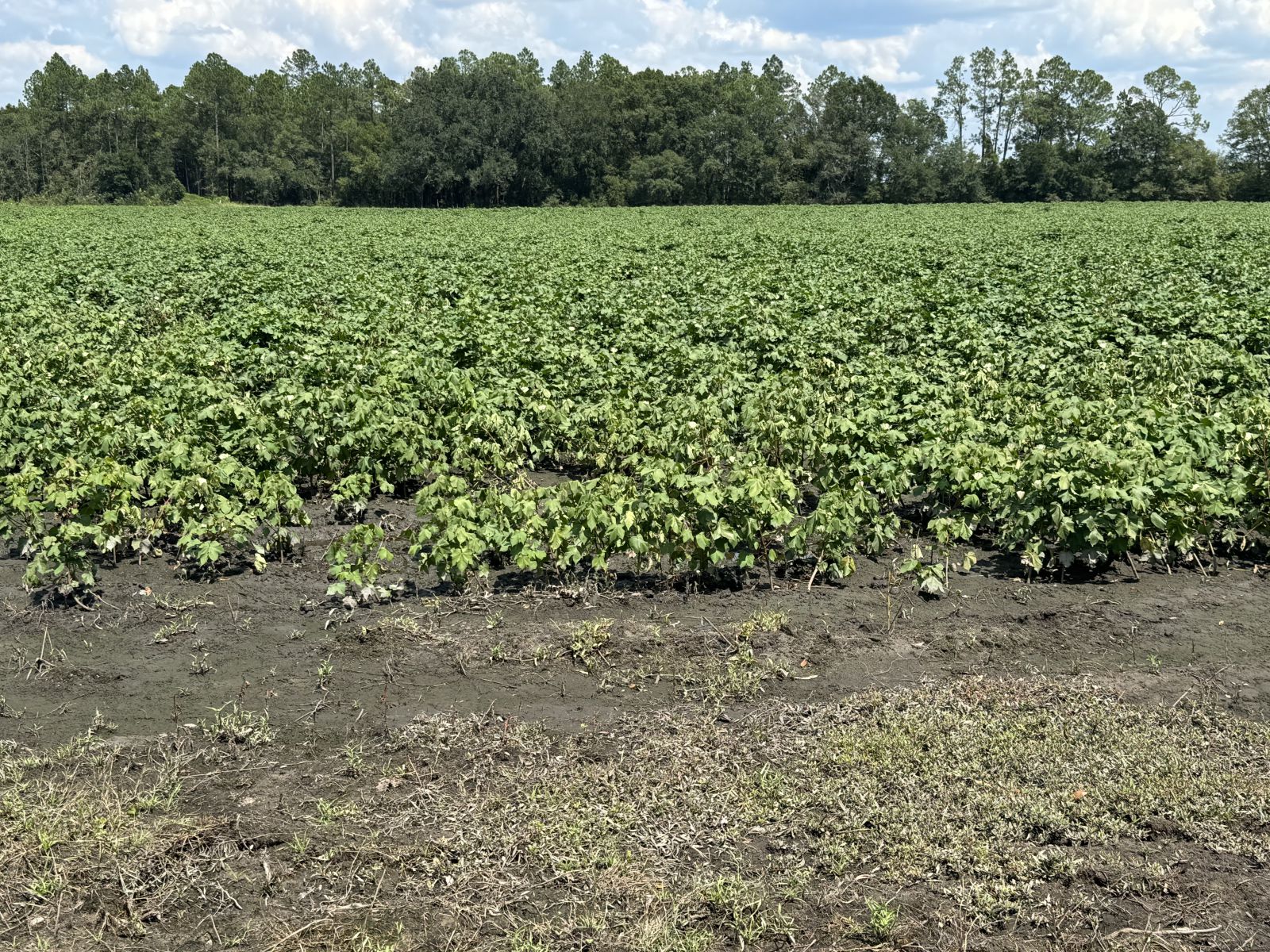
Debby dumped 10 to 12 inches of rain on David Morgan’s Ware County cotton and peanut farm. On Aug. 13, there was still a steady stream of water running out of this field. Morgan said this is some of the wettest land he tends. / Photo by Kane Staines
While Morgan says it’s too early to know the full extent of damage to either crop, he says he’s seeing signs of damage.
“In places we have some drowned cotton and, in some places, in our older cotton, we have stalks blown over or lodged [twisted]. Having twisted stalks makes it hard to harvest the crop,” Morgan said. “I just hope our crops are not eat up with disease in the next 10 days. That’s why we’re spraying fungicides, trying to prevent that.”
Morgan said cotton fields he has on the west side of Ware County seem to have more wind damage than those he has in the east side of the county, but he got more rain on his fields on the east side.
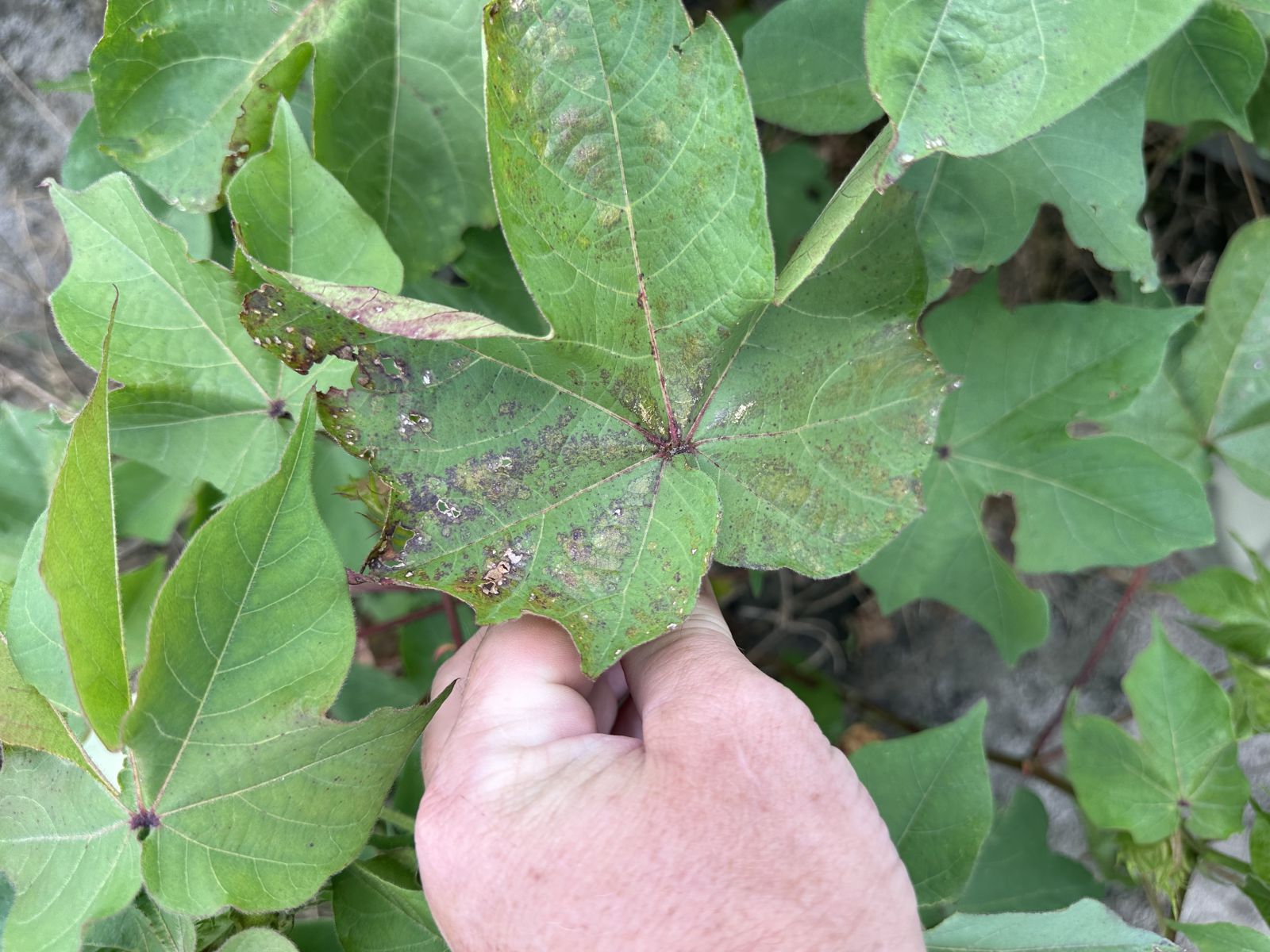
David Morgan is also seeing his cotton shed fruit, and some of his cotton stalks are starting to turn red and the leaves turn purple. / Photo by Kane Staines
“This is because the cotton plants have gotten too much water and have a lack of oxygen,” Morgan explained.
He’s concerned the excess rain leached fertilizer and nutrients from his fields, so Morgan is starting to apply foliar fertilizer and fungicides to help his cotton and peanuts fight the threat of diseases.
Farming his 17th crop, Morgan, 36, says he had a similar experience to this in 2017 when Tropical Storm Irma hit in September, but then, his crops were further along.
Visit https://gfb.ag/peanutpodcast224 to hear members of the UGA Extension Peanut Team discuss disease issues like white mold and leaf spot that Georgia peanut growers may experience after Debby deluged fields in Southeast Georgia. Look for Season 2, Episode 24 recorded Aug. 9.
“We’re moving into the time of the year when we start to see disease developing in peanuts anyway. You can’t stop all disease but there are things we can do.
Monfort says timeliness of fungicide applications is important. If the storm has left your peanut fields saturated, and you think you need to spray don’t wait until you can get equipment back into field try to get an airplane to spray fungicide.
“With the tropical storm that came through, West Georgia and Central Georgia in Tifton, we got about 2 inches, which is plenty if we want to see a white mold outbreak,” UGA Extension Pathologist Bob Kemerait said. “Temperatures are climbing back up into the 90s, which is absolutely perfect for white mold. I’m getting a lot of pictures from agents & consultants showing white mold active in the field.”
Water, water everywhere
Evans Co. farmer Gary Bell, 67, called TS Debby “a once- in-a-lifetime” event. Bell, who grows pecans, pine seedlings, peanuts, cotton and cattle estimates he received 14-16 inches of rain Aug. 5 and 6. From then to Aug. 13, Bell said flooded spots on his farm went from being covered with as much as two feet of water to only four-five inches.
“It’s drying off in a hurry now the temperatures have climbed back into the 90s, but we still have water hanging around in low spots,” Bell said. “We only have two to three bad spots in our cotton and grazing pasture. I’d estimate about five acres are still under water on our whole farm.”
.jpg)
Bell has a low spot in his driveway that goes from the highway that runs through his farm to his house. Right after Debby passed through, Bell had about four feet of standing water in this low spot, where runoff collects from the highway and surrounding 75 acres of pasture and a pecan orchard. / Photo by Gary Bell
Despite having drain tiles installed in the low spot and running a pump, there were still eight to 10 inches of water in this section of his driveway a week after the storm.
“I’ve never known this spot to be more than two feet deep with water,” Bell said. “We were blessed that the water didn’t come in our house. We have a lot of neighbors who had water come in their houses, two to three feet deep.”
Gary and his brother, Danny, have about 34 acres of pine seedlings.
They've already been able to pull dirt through the alleys between their raised pine seedling beds to build back up any dirt that washed away.
“Our pine seedlings faired good with very little damage. We may have lost about 10% of our seedlings growing on the edge of the beds,” Bell said.
“It’s something we’ve never experienced before, this much rain. Hopefully it will dry out and we’ll recover. You’ve got to be positive.”
Pecans orchards saturated
By Jay Stone
Jennifer Whittaker contributed content to this section.
The soils across much of South Georgia were already saturated because of rains prior to Debby’s arrival. According to UGA Extension Area Pecan Agent Andrew Sawyer, Waycross and Blackshear had 10 inches of rain before the hurricane. Sawyer said some orchards may have lost at much as 10% of the nuts from the trees.
There was some random tree loss across Southeast Georgia. The Georgia Department of Agriculture reported that a Brooks County farm lost as many as 500 trees.
“They are affected by wet, flooded soils,” Sawyer said. “One tells me they will be back in the orchard this week.”
UGA Extension Pecan Agronomist Lenny Wells echoed concerns about excessive water.
“One problem in those areas where flooding occurred is that many of the nuts blown off the trees were carried away by flood waters, making it a little harder to assess,” Wells said, noting that pecans can handle short-term flooding like that in the short term, but the timing of the storm, coinciding with a key point in the pecans’ development, could result in residual effects in next year’s crop. “I don’t know that I’ve ever seen flooding like this on them at this time of year.”
Wells said early-maturing Pawnee variety pecans seem to have been hardest-hit in terms of nut loss, with some orchards losing as much as 20%, according to an Aug. 12 blog post on the Extension Pecan page, where he noted that reduced crop quality could result from storm winds.
The Georgia Department of Agriculture reported that a Brooks County farm lost as many as 500 trees.
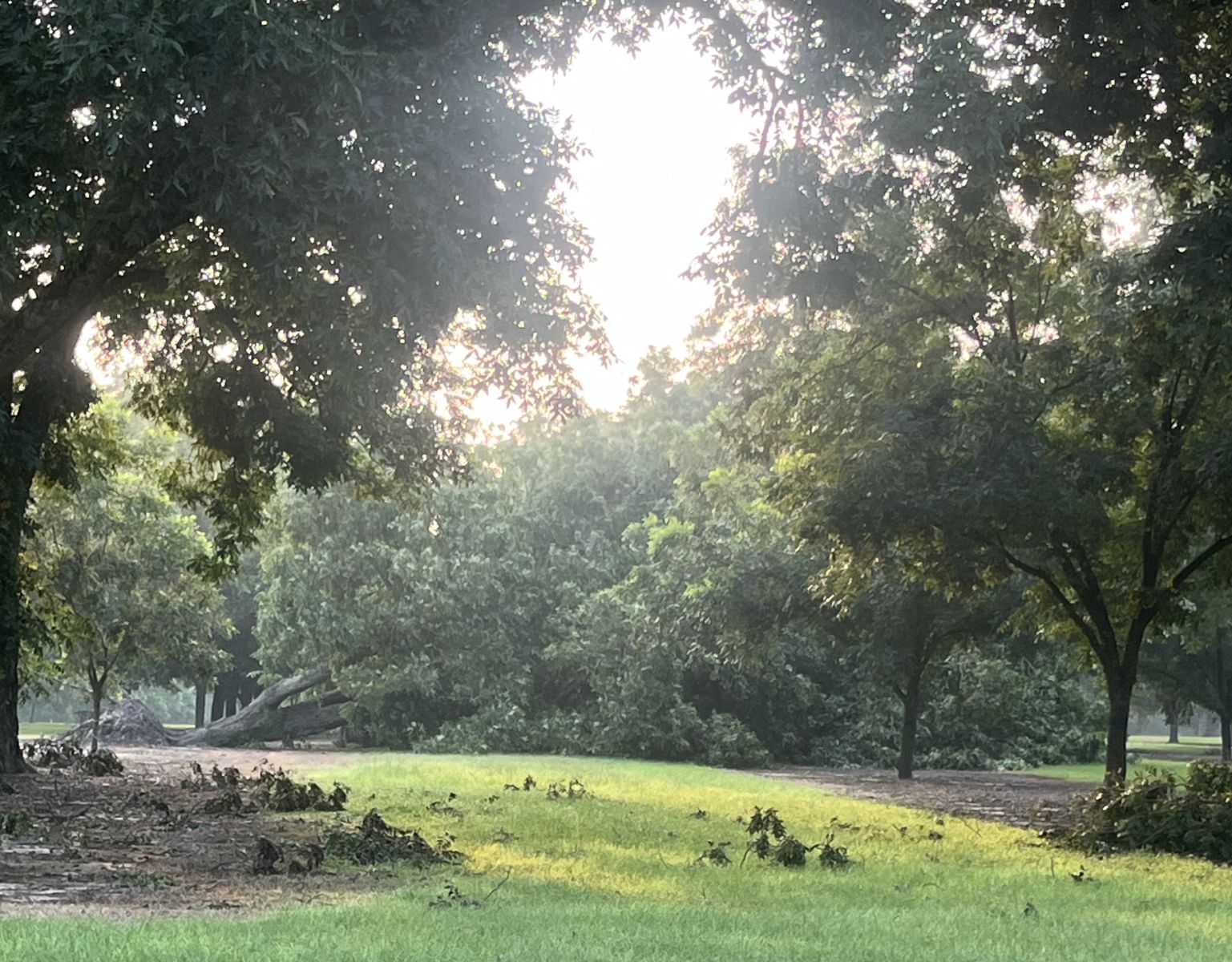
The Bell Brothers in Evans County have about 150 acres of pecans. Gary estimates they had 10 pecan trees fall over due to a combination of strong wind and saturated soil. Six of the trees were more than 80 years old; four were 15-20 years old. / Photo by Gary Bell
Debby latest adverse weather in ’24 growing season
Like many farmers in parts of Southeast Georgia, Debby isn’t the first adverse weather Georgia farmers have dealt with this year, but hopefully she will be the last.
Daniel Johnson got a lot of rain in April and May during his planting season that caused him to have to replant 120 acres of peanuts due to flooding in early May.
Although Johnson has crop insurance, he says, “The question is will it be enough to pay my debt? We’re just hoping for the best.”
“We never had to replant tobacco, but we had to refertilize every acre to get the crop to come on,” Johnson said.
Then, it turned dry in June on his farm and didn’t rain until July 19, making it necessary for Johnson to replant about 150 acres of cotton due to June’s dry weather.
Since then, Johnson estimates he received 19 inches before Debby arrived.
For Lindy Sheppard, the storm is making a financially tight year harder.
“We were already looking at a bleak year financially because of higher input costs for everything – fertilizer, fuel, equipment, equipment repairs – and lower commodity prices,” Sheppard said.
David Morgan had to replant peanuts because of too much rain in May.
In addition to having one of the most weather adverse growing seasons, farmers are also contending with an economic storm caused by high production costs and low commodity prices.
“We were already in a storm no one understands,” Georgia Peanut Commission Executive Director Don Koehler said. “I had one banker tell me this may cause him to lose half of their farmers because of the carry forward debt farmers already have.”
- Categories:
- Tags: